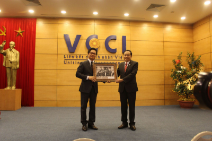Solutions for sustainable marine farming
To protect marine resources, which are being overexploited, and boost the sustainable marine economy, mariculture or marine farming is a strong development approach.
Untapped mariculture
Vietnam’s mariculture potential is huge. According to the Directorate of Fisheries, the country’s marine farming area is about 5,000 square kilometers. In 2010 - 2019, marine farming made significant progress in area and output. The total mariculture area in 2019 was over 256,000 ha, 23.3% larger than a year earlier. The output was nearly 598,000 tons in the year, up 16%.

Illustrative photo
Boosted by strong growth, Vietnam has over 50 marine hatcheries that produce over 510 million fish a year. Artificial reproduction technology has been completed and seed production technology has been successfully transferred in many localities, helping develop commercial marine resources.
However, mariculture is still fragmented and small, not fully tapping its potential and natural advantages. Marine farming infrastructure investment is limit ed, scattered, inconsistent and ineffective.
In addition, most marine varieties have to be imported through unofficial channels, with precarious quality and low farming efficiency. Cage farming is not properly planned and densely installed near the shore, leading to environmental degradation and affecting other economic sectors such as tourism and shipping.
Solutions for sustainable mariculture development
To create branded products, meet domestic and export market needs, generate jobs and increase incomes for coastal communities, the marine farming development project to 2030, with a vision to 2045, was launched.
According to the project, by 2025, the marine farming area will reach 280,000 ha, the cage fishing capacity will reach 10 million cubic meters; the marine farming output will climb to 850,000 tons; the export value will rise to US$0.8-1 billion, expected to reach US$1.8-2 billion by 2030.
With a vision to 2045, Vietnam’s marine farming industry will be advanced and modernized. It will become an important sector of the fisheries, account for over a quarter of total output and earn an export value of over US$4 billion.
The most important approach of the project is synchronous marine farming infrastructure development: Building technical infrastructure for offshore fishing development; forming logistics service fleets for mariculture, from transporting seeds and feed to harvesting, processing and preservation; applying industrial farming methods, with priority given to multi-species farming development suitable for each ecological region and environmental capacity, coupled with resource protection, development and management in intertidal areas, lagoons and coastal mangroves.
Modern, large-scale industrial farming is adopted to ensure food safety, protect the ecological environment, and adapt to climate change. Weather-resilient structures and materials are used in cage fishing.
The project focuses on tapping local advantages. Accordingly, Hai Phong and Quang Ninh will become a marine farming center where large fisheries are formed, coupled with marine conservation and national tourism. Coastal provinces from Thanh Hoa to Binh Thuan will develop mariculture, seafood processing, logistics services, marine farming infrastructure, effective and sustainable management.
Provinces from Ba Ria - Vung Tau to Kien Giang will build and develop mariculture based on their favorable conditions; harmonize mariculture with services, tourism, oil and gas, wind power and seafood processing.
Offshore marine farming zones will be established in key provinces such as Quang Ninh, Hai Phong, Quang Ngai, Phu Yen, Khanh Hoa, Ninh Thuan, Binh Thuan, Ba Ria - Vung Tau, Ca Mau, Kien Giang and some other locations.








